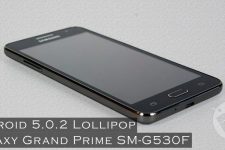
Android Lollipop may have been out since a while now, it brought ample of new features and improvements, but it also incurred a few bugs which caused huge memory leaks and battery shortage. Which is again, a dark side to this awesome update. However Google has worked hard and fixed a few with the 5.0.1 release, which followed up to every supported Nexus flagship. 5.0.1 was meant to bring along battery related fixes, but not all of the related ones were fixed.
Lately, Google released 5.0.2 to the public, both on AOSP and OTAs, and now it has been let out as Factory Images to the Nexus 7 variants and the Nexus 10. The 5.0.2 release is focused on bringing fixtures and upgrades to the Nexus 7, a single change to the Nexus 9 specifically and a few more changes to accompany. Below are the changes that have been pulled raw from the 5.0.2 AOSP release.
Changelog
- grouper: update prebuilt kernel
- grouper: emulate sdcard using 4 threads
- grouper: update prebuilt kernel and power hal
- grouper: power hal: improve interactive loads
- tilapia: emulate sdcard using 4 threads
- tilapia: chown and chmod core_lock_{count,period} sysfs files
- Trim fingerprint.
- Update volantis workaround to cover L MR0.5 (5.0.2)
- Fix bad alarm delivery
- Tune delivery and batching of alarms
- Properly recognize repeating wakeup alarms
- Be increasingly aggressive about fstrim if it isn’t being run
- Start MountService before performBootDexOpt
Warning!
Installing factory images is a risky process if you do not know what you’re doing. It will wipe everything off your device. DroidViews or any of its community members shall not be held responsible for any damage to your Nexus 7 or Nexus 10.
Preparations
- Enable USB Debugging in Developer options under Settings if you don’t know how, follow our detailed guide.
- Android tools package for ADB and Fastboot binaries, extract the android-tools.zip. If you already have SDK installed and setup with all the tools, skip this step: Link
- Backup everything before you proceed, this includes storage, messages, contacts etc.
- Charge your device to at least 60% battery life to avoid any mishaps during the process.
- WinRAR archive manager: Link
Install Lollipop 5.0.2 Factory Images
1. Nexus 7 2012 (Wi-Fi)
- Download the factory image for your Nexus 7 (nakasi): nakasi-lrx22g-factory-2291c36b.tgz
- Open the location where the factory image has been downloaded, now right-click on the file and select Extract Here.
- You will now have a folder name nakasi-lrx22g containing all the files – bootloader and firmware file.
- Copy the contents of the extracted android-tools folder to the nakasi-lrx22g folder.
- Open the nakasi-lrx22g folder, press SHIFT key and right-click on an empty space inside the folder, select Open command window here.
- Connect your Nexus 7 to the PC via USB data cable.
- Enter the command to reboot your device into bootloader mode:
adb reboot bootloader
- Flash the bootloader first, type:
fastboot flash bootloader bootloader-grouper-4.23.img
- Reboot the bootloader, type:
fastboot reboot-bootloader
- Flash the firmware file, type:
fastboot -w update image-nakasi-lrx22g.zip
- Nexus 7 will reboot automatically when the process completes, you can disconnect the device now.
2. Nexus 7 2013 (Wi-Fi)
- Download the factory image for your Nexus 7 (razor): razor-lrx22g-factory-bff2093e.tgz
- Open the location where the factory image has been downloaded, now right-click on the file and select Extract Here.
- You will now have a folder name razor-lrx22g containing all the files – bootloader and firmware file.
- Copy the contents of the extracted android-tools folder to the razor-lrx22g folder.
- Open the razor-lrx22g folder, press SHIFT key and right-click on an empty space inside the folder, select Open command window here.
- Connect your Nexus 7 to the PC via USB data cable.
- Enter the command to reboot your device into bootloader mode:
adb reboot bootloader
- Flash the bootloader first, type:
fastboot flash bootloader bootloader-flo-flo-04.04.img
- Reboot the bootloader, type:
fastboot reboot-bootloader
- Flash the firmware file, type:
fastboot -w update image-razor-lrx22g.zip
- Nexus 7 will reboot automatically when the process completes, you can disconnect the device now.
3. Nexus 10
- Download the factory image for your Nexus 10 (mantaray): mantaray-lrx22g-factory-81af84cb.tgz
- Open the location where the factory image has been downloaded, now right-click on the file and select Extract Here.
- You will now have a folder name mantaray-lrx22g containing all the files – bootloader and firmware file.
- Copy the contents of the extracted android-tools folder to the mantaray-lrx22g folder.
- Open the mantaray-lrx22g folder, press SHIFT key and right-click on an empty space inside the folder, select Open command window here.
- Connect your Nexus 10 to the PC via USB data cable.
- Enter the command to reboot your device into bootloader mode:
adb reboot bootloader
- Flash the bootloader first, type:
fastboot flash bootloader bootloader-manta-mantamf01.img
- Reboot the bootloader, type:
fastboot reboot-bootloader
- Flash the firmware file, type:
fastboot -w update image-mantaray-lrx22g.zip
- Nexus 10 will reboot automatically when the process completes, you can disconnect the device now.
You now have the latest Android Lollipop 5.0.2 running on your Nexus 7 and Nexus 10. Factory Images and binaries for the respective devices are available here on Google. Have you installed the latest image on your device? Give us a feedback via comments, it will help us build a better community.



Join The Discussion: